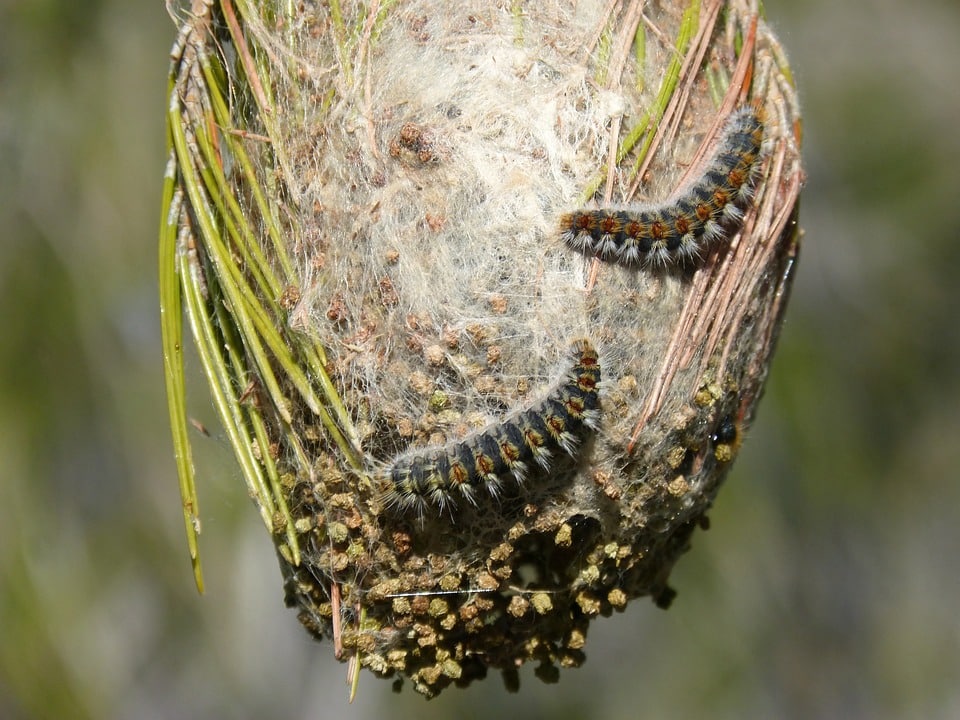How to keep your furry friend safe
By Helen Coombes
The processionary pine caterpillar (Thaumetopoea pityocampa) is a common insect found in Cyprus that can pose a serious risk to humans and pets. Due to the warm weather, the processionary caterpillars are hatching earlier than usual this year in Cyprus. These caterpillars get their name from the way they typically nest in pine trees and then move in a line, or “procession,” as they forage for food.
The nest of the processionary caterpillar is a large, silken structure found in pine trees. The caterpillars construct the nest by spinning a thick layer of silk, which they use to enclose and protect themselves as they develop. The nests are often covered in debris, such as pine needles and leaves, to blend in with their surroundings. The caterpillars remain inside the nest for most of their development, only venturing out to forage for food at night.
When the caterpillars are ready to pupate, they drop to the ground, form a long procession and search for a suitable location to spin their cocoons. It is thought that this processionary behaviour offers them protection from birds, as the moving line of caterpillars can resemble a snake and may confuse predators.
One potentially dangerous feature of the processionary pine caterpillar, is that the white hairs that cover its body contain a toxic substance that can cause skin irritation and allergic reactions in humans and animals. When threatened, the caterpillars can even eject these urticating hairs at animals that are nearby, for instance sniffing them, making them a particular threat to curious pets. When walking your dog in areas where processionary pine caterpillars may be present, it is important to keep your pets on a lead or avoid areas where the caterpillars are active.
If your pet comes into contact with a processionary caterpillar or inhales the toxic hairs, they may experience various symptoms including drooling, swelling of the mouth and tongue or redness, itching, and swelling of the skin which is painful to touch. The toxic hairs can cause difficulty breathing, coughing or sneezing so if you or your dog experiences any of these symptoms, it is important to immediately seek medical attention.
While the toxic hairs of the processionary caterpillar can pose a serious threat to humans and pets, some birds are immune to the toxin and can safely consume the caterpillars. Some migratory birds to Cyprus, including the Great spotted cuckoo, Common cuckoo, European nightjar and Eurasian hoopoe, are regular predators of the pine processionary moth and are known to feed on the caterpillars and are not affected by their toxic hairs.
Control of the processionary pine caterpillar can be difficult, as the caterpillars are well-protected by their toxic hairs. The best way to control the processionary pine caterpillar is to prevent them from hatching in the first place. If you see the silky, weblike nests, contact a professional pest control service to remove the nest before the caterpillars hatch. If the caterpillars have already dropped to the ground, pesticides are not always effective and may also harm other insects and animals. A simple and effective way to control them is to lay a box in their path. The caterpillars will walk into the box and can then be safely disposed of or relocated. It is important to note that the hairs remain toxic even after the caterpillar is dead, so killing them as they march and trying to sweep them up, can whisk their hairs up into the air, which disperses them and the danger to people and pets remains.
It is important to distinguish between the processionary pine caterpillar and the local “martouthkia” caterpillar, scientific name – Ocnogyna ioewii. The martouthkia caterpillar is a native species found in Cyprus and other parts of the Mediterranean. These caterpillars hatch under a web-like structure on the ground, often in grass, and remain in a tight group as they grow. The ball or caterpillars rolls very slowly along as the caterpillars take turns to be in the vulnerable position of being at the top before moving to the bottom of the group to feed. They remain in this clump until they grow big enough to disperse.
The easiest way to tell the two species of caterpillar apart, is by their behaviour. The harmless martouthkia are not in pine trees and they do not form a procession.
The martouthkia caterpillars are often confused with the toxic processionary caterpillars, and despite their harmless nature, this leads to the unnecessary killing of large numbers of this harmless species. Education about these two different species, taking precautions and following control measures will help protect people and animals from coming into contact with processionary pine caterpillars and help prevent the needless destruction of the harmless martouthkia.








Click here to change your cookie preferences